Influence of Si and SiC Coating on the Microstructures and Mechanical Properties of C/C Bolts
Abstract
1. Introduction
2. Materials and Methods
2.1. Preparation of C/C and C/C−SiC Bolts
2.2. Measuring the Mechanical Properties
2.3. Observation of Microscopic Structures
2.4. Phase Composition Analysis
3. Results and Discussion
3.1. Microstructure and Phase Composition
3.2. Mechanical Properties
3.2.1. Tensile Properties
3.2.2. Double−Sided Shear Properties
3.3. Failure Mechanisms
3.3.1. Tensile Failure
3.3.2. Double−Sided Shear Failure
4. Conclusions
- A continuous and dense SiC/Si coating was formed on C/C bolts by silicon infiltration modification. The coating was distributed continuously and densely. The SiC−Si coating was tightly bonded with bolts through the pinning effect. There was no obvious delamination, and the coating filled the pores of C/C threads.
- The mechanical properties of C/C bolts after silicon infiltration modification were significantly enhanced, exhibiting a tensile strength of 55.16 MPa and a double−sided shear strength of 54.73 MPa. Compared with unmodified C/C bolts, the tensile strength and double−sided shear strength of the modified bolt increased by 26.83% and 24.73%, respectively. The tensile failure of C/C−SiC bolts was caused by the breakage of studs, and the double−sided shear failure was induced by the crushing of threads and shear fracture of studs. Under tensile stress, the tensile load was transferred from threads to studs through the coating, and the failure mode changed from the pull−out of threads to the breakage of studs. This provided the fiber−toughening mechanism and increased the load−bearing capacity of the bolt.
- The failure mechanism of the C/C bolts did not vary after silicon infiltration modification. C/C and C/C−SiC bolt failures consisted of matrix cracking, fiber debonding, and fiber bridging. The SiC and C coating formed by silicon infiltration modification could effectively bear and transmit loads to the internal C matrix and C fiber, thus exerting the reinforcing and toughening effect on the bolts.
Author Contributions
Funding
Institutional Review Board Statement
Informed Consent Statement
Data Availability Statement
Acknowledgments
Conflicts of Interest
References
- Windhorst, T.; Blount, G. Carbon−carbon composites: A summary of recent developments and applications. Mater. Des. 1997, 18, 11–15. [Google Scholar] [CrossRef]
- Ma, C.C.M.; Nyan−Hwa, T.; Wen−Chi, C.; Yi−Pin, T. Morphologies, microstructure and mechanical properties of 2D carbon/carbon composites during the CVI densification process. Carbon 1996, 34, 1175–1179. [Google Scholar] [CrossRef]
- Gajiwala, H.M.; Vaidya, U.K.; Sodah, S.A.; Jeelani, S. Hybridized resin matrix approach applied for development of carbon/carbon composites. I. Carbon 1998, 36, 903–912. [Google Scholar] [CrossRef]
- Delhaes, P. Chemical vapor deposition and infiltration processes of carbon materials. Carbon 2002, 40, 641–657. [Google Scholar] [CrossRef]
- Böhrk, H.; Beyermann, U. Secure tightening of a CMC fastener for the heat shield of re−entry vehicles. Compos. Struct. 2010, 92, 107–112. [Google Scholar] [CrossRef]
- Qian−Gang, F.; Hui, X.; Heng, W.; He−Jun, L.; Ke−Zhi, L.; Jun, T. A hot−pressing reaction technique for SiC coating of carbon/carbon composites. Ceram. Int. 2010, 36, 1463–1466. [Google Scholar] [CrossRef]
- Sun, G.; Zhang, C.; Zhang, Q.; Zhang, Y.; Cheng, L.; Luan, X.; Yang, C. Microstructure and mechanical properties of SiCf/SiC composite prepared by chemical vapor infiltration. Ceram. Int. 2022, 48, 36983–36991. [Google Scholar] [CrossRef]
- Tang, S.-F.; Zhao, R.-D.; Hu, C.-L.; Wang, P.-Y.; Pang, S.-Y. Carbon Fiber Preform’s Structure on Mechanical Property of C/C Composites and Bolts. J. Inorg. Mater. 2019, 34, 1272–1278. [Google Scholar]
- Zhang, Y.; Zhou, Z.; Pan, S.; Tan, Z. Comparison on failure behavior of three−dimensional woven carbon/carbon composites joints subjected to out−of−plane loading at room and high temperature. Compos. Commun. 2021, 23, 100567. [Google Scholar] [CrossRef]
- Tang, Y.; Zhou, Z.; Pan, S.; Xiong, J.; Guo, Y. Mechanical property and failure mechanism of 3D Carbon–Carbon braided composites bolted joints under unidirectional tensile loading. Mater. Des. 2015, 65, 243–253. [Google Scholar] [CrossRef]
- Ren, J.; Li, K.; Zhang, S.; Yao, X.; Li, H. Preparation of high texture three−dimensional braided carbon/carbon composites by pyrolysis of ethanol and methane. Ceram. Int. 2016, 42, 2887–2891. [Google Scholar] [CrossRef]
- Sun, Y.; Sun, Y. Precursor infiltration and pyrolysis cycle−dependent mechanical and microwave absorption performances of continuous carbon fibers−reinforced boron−containing phenolic resins for low−density carbon−carbon composites. Ceram. Int. 2020, 46, 15167–15175. [Google Scholar] [CrossRef]
- Wan, F.; Liu, R.; Wang, Y.; Sun, G.; Cao, Y.; Zhang, C. Microstructure characterization and compressive performance of 3D needle−punched C/C–SiC composites fabricated by gaseous silicon infiltration. Ceram. Int. 2019, 45, 6897–6905. [Google Scholar] [CrossRef]
- Scott Bobbitt, N.; Chelikowsky, J.R. First−principles calculations of Raman spectra in Li−doped Si nanocrystals. Chem. Phys. Lett. 2016, 646, 136–141. [Google Scholar] [CrossRef]
- El khalfi, A.-I.; Ech-chamikh, E.; Ijdiyaou, Y.; Azizan, M.; Essafti, A.; Nkhaili, L.; El Kissani, A.; Tomasella, E. FTIR and Raman study of rapid thermal annealing and oxidation effects on structural properties of silicon-rich Si x C 1-x thin films deposited by R.F co−sputtering. Vib. Spectrosc. 2017, 89, 44–48. [Google Scholar] [CrossRef]
- Luan, X.; Liu, G.; Tian, M.; Chen, Z.; Cheng, L. Damage behavior of atomic oxygen on a hafnium carbide−modified C/SiC composite. Compos. Part B Eng. 2021, 219, 108888. [Google Scholar] [CrossRef]
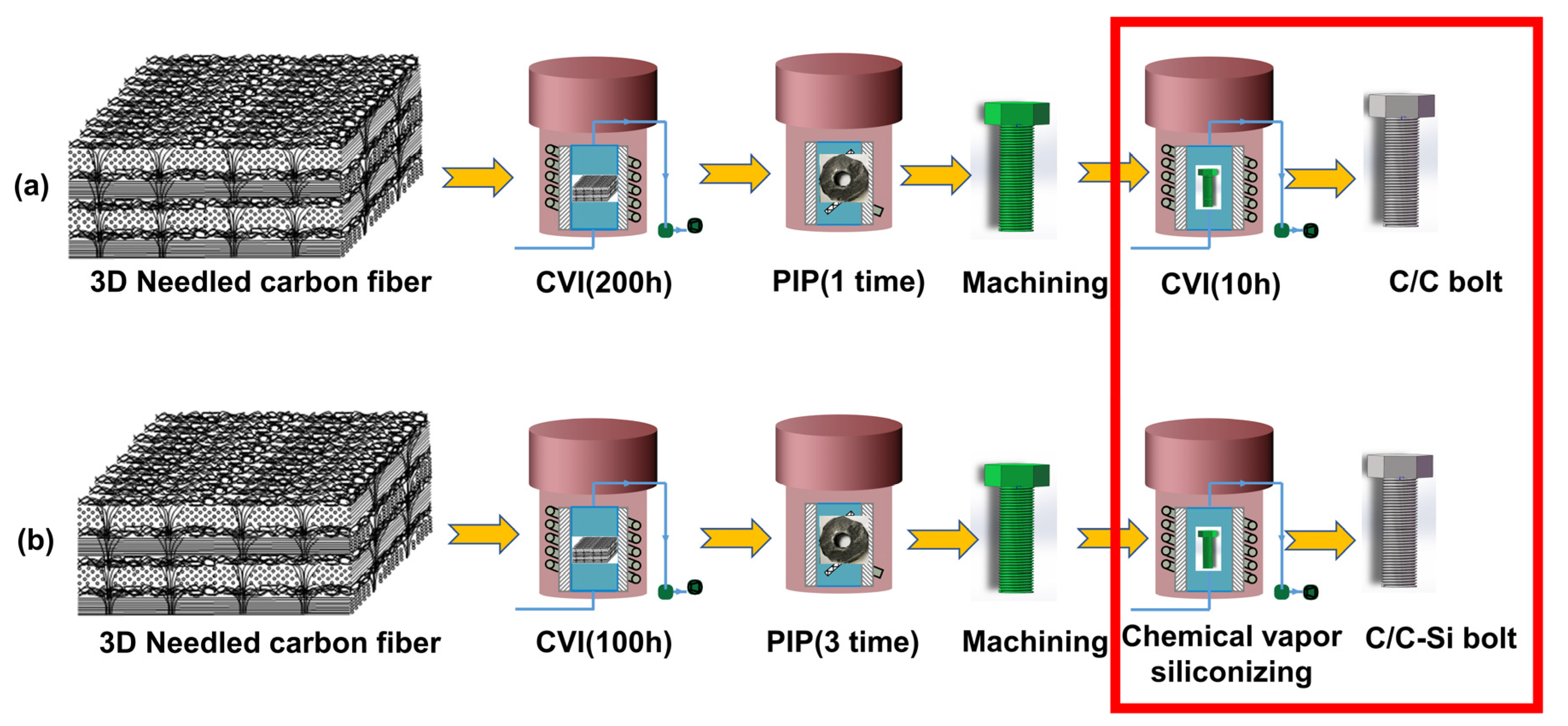
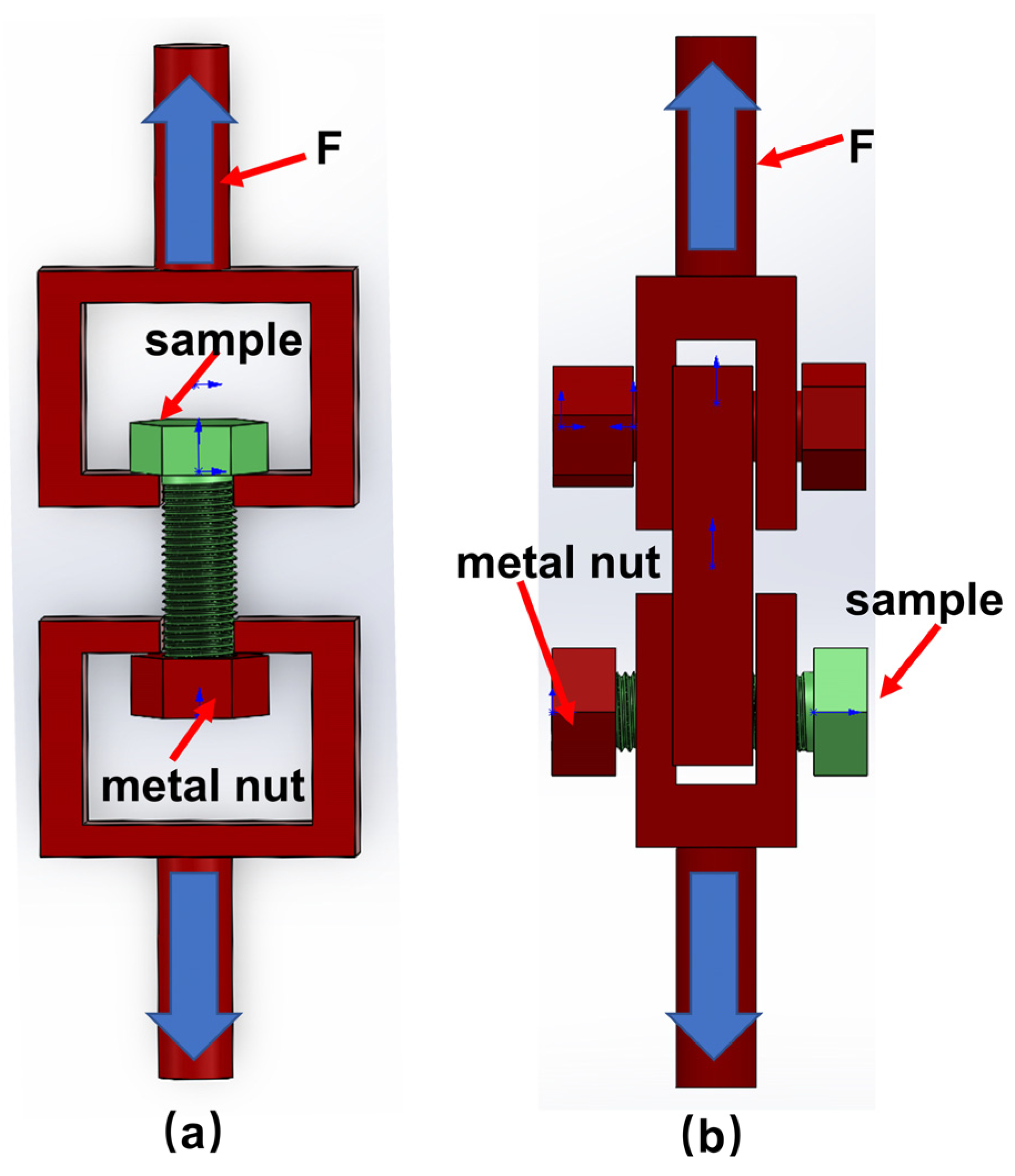
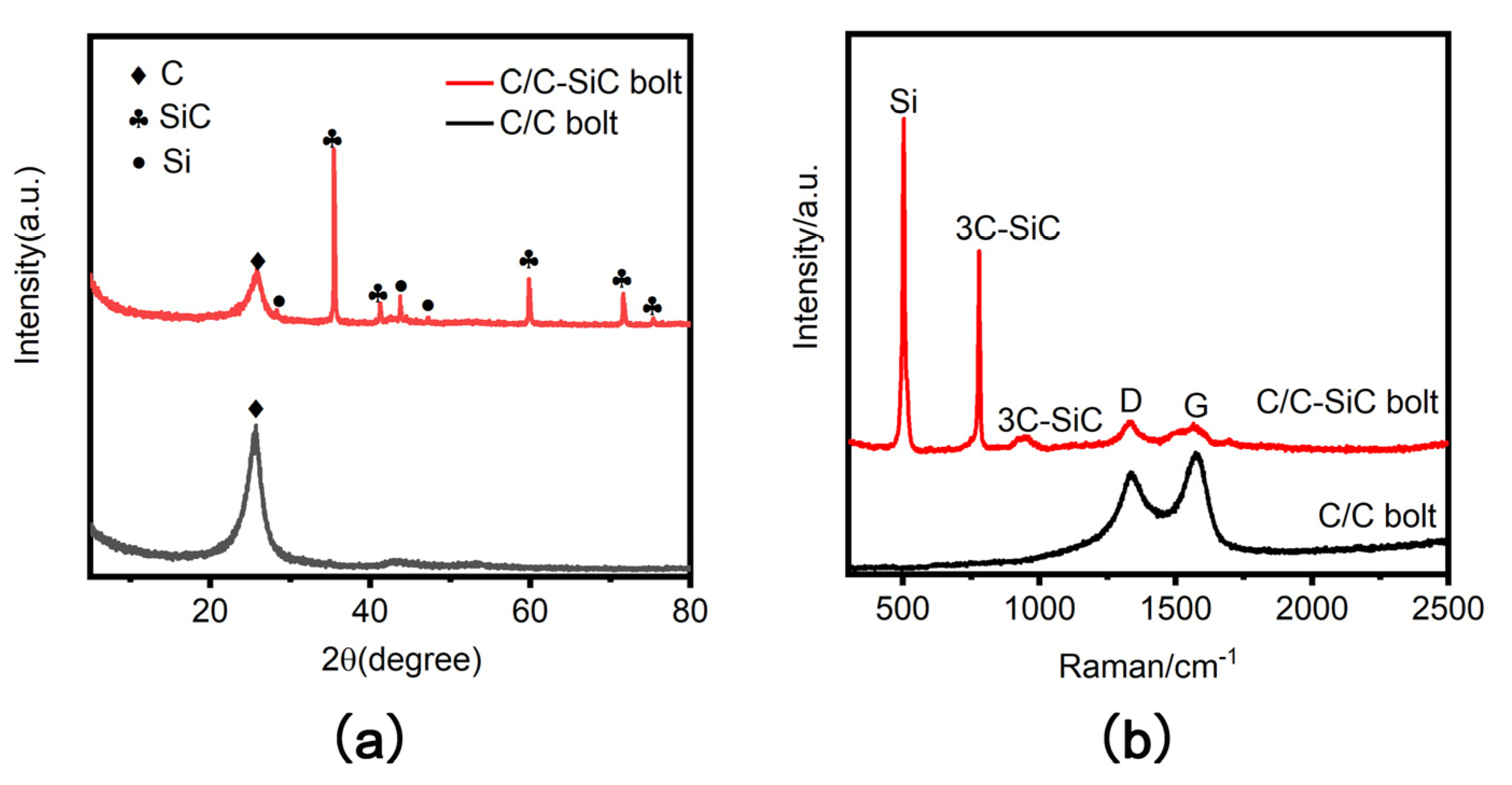

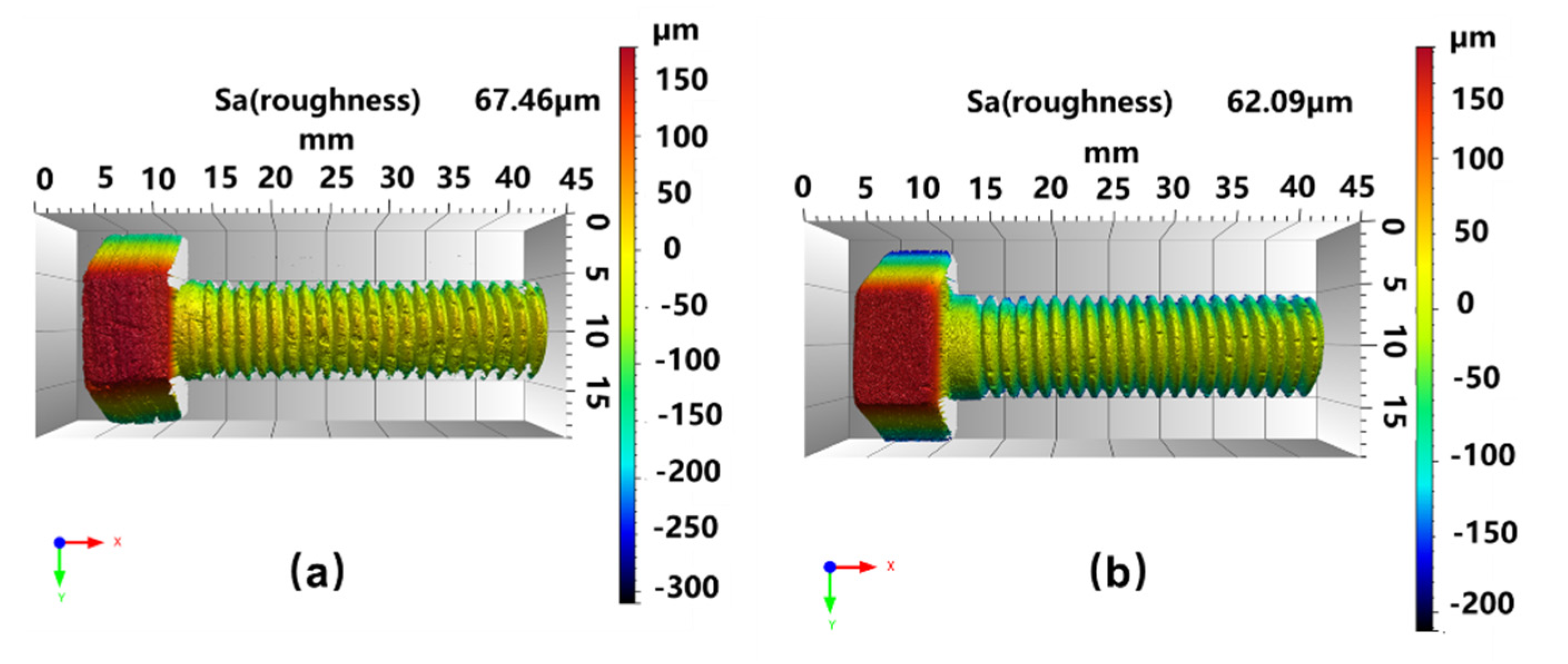
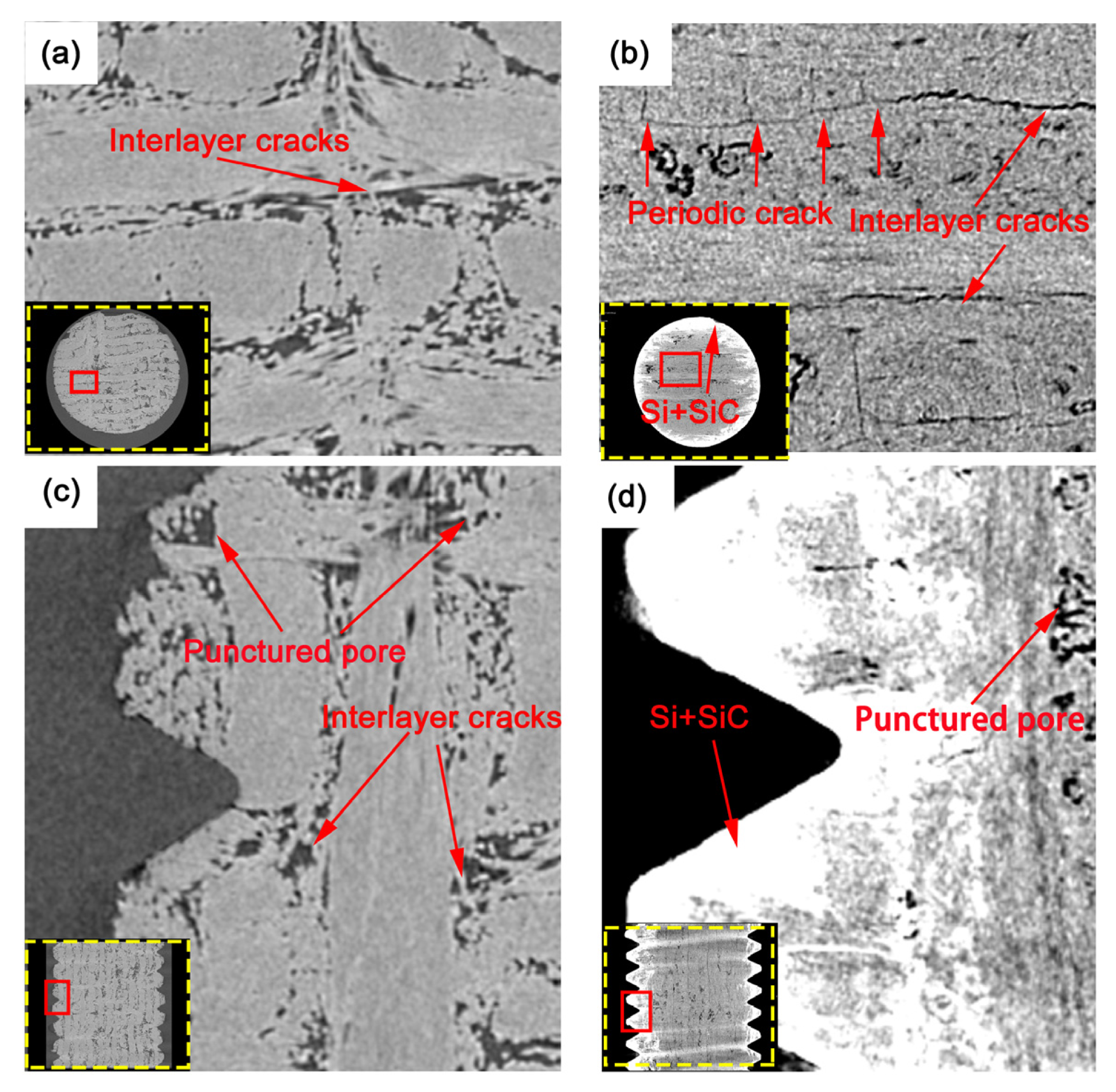

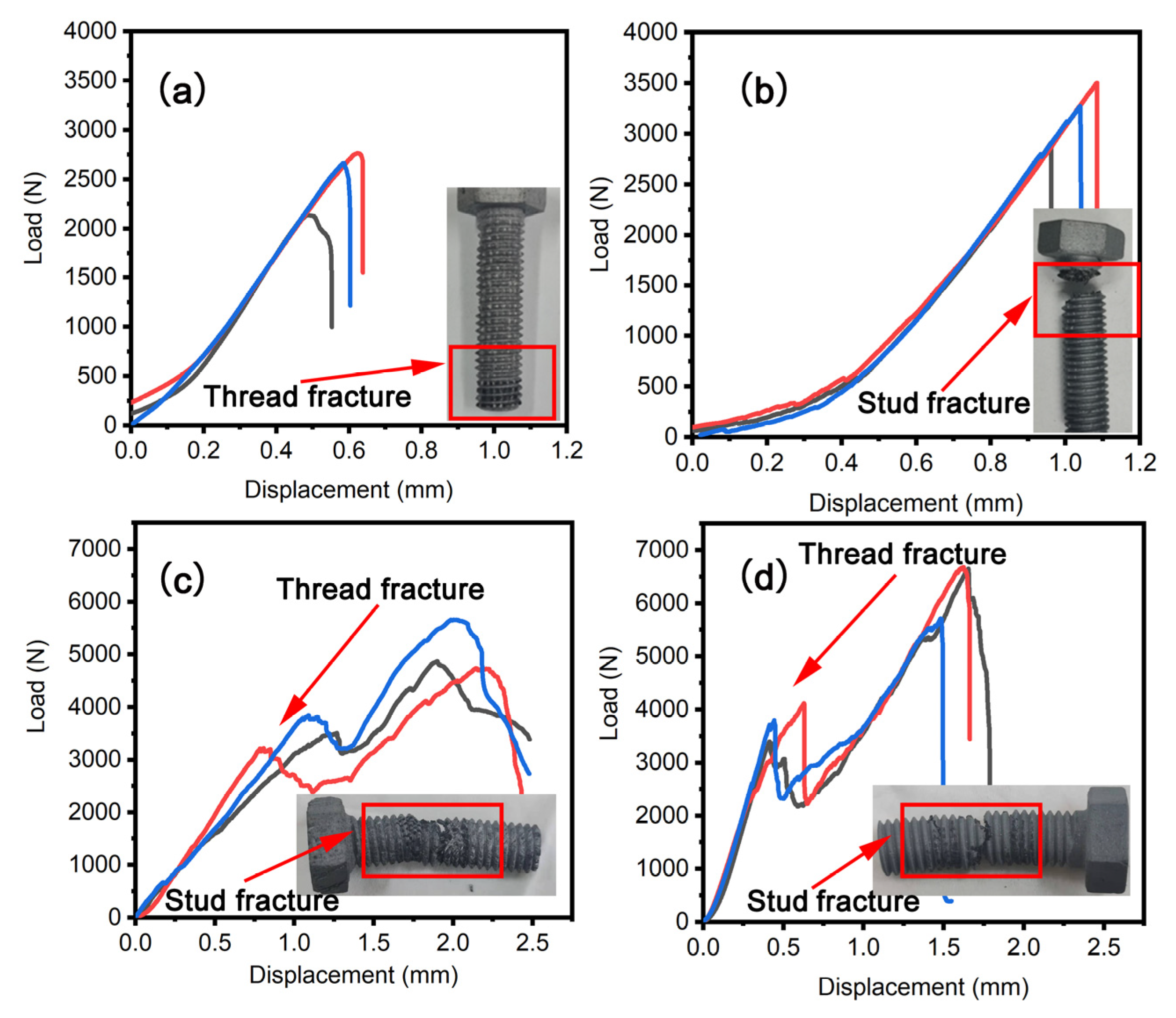

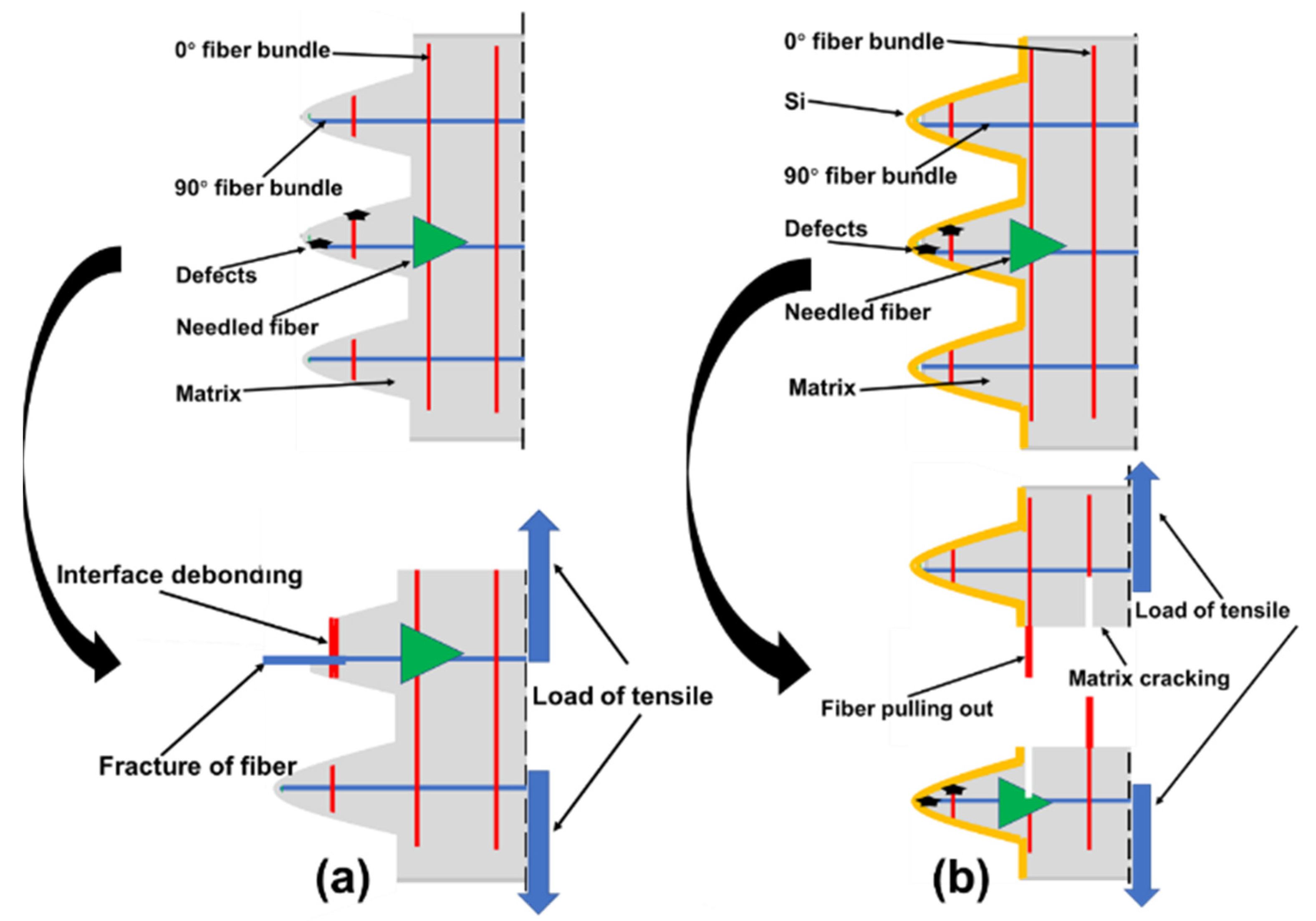
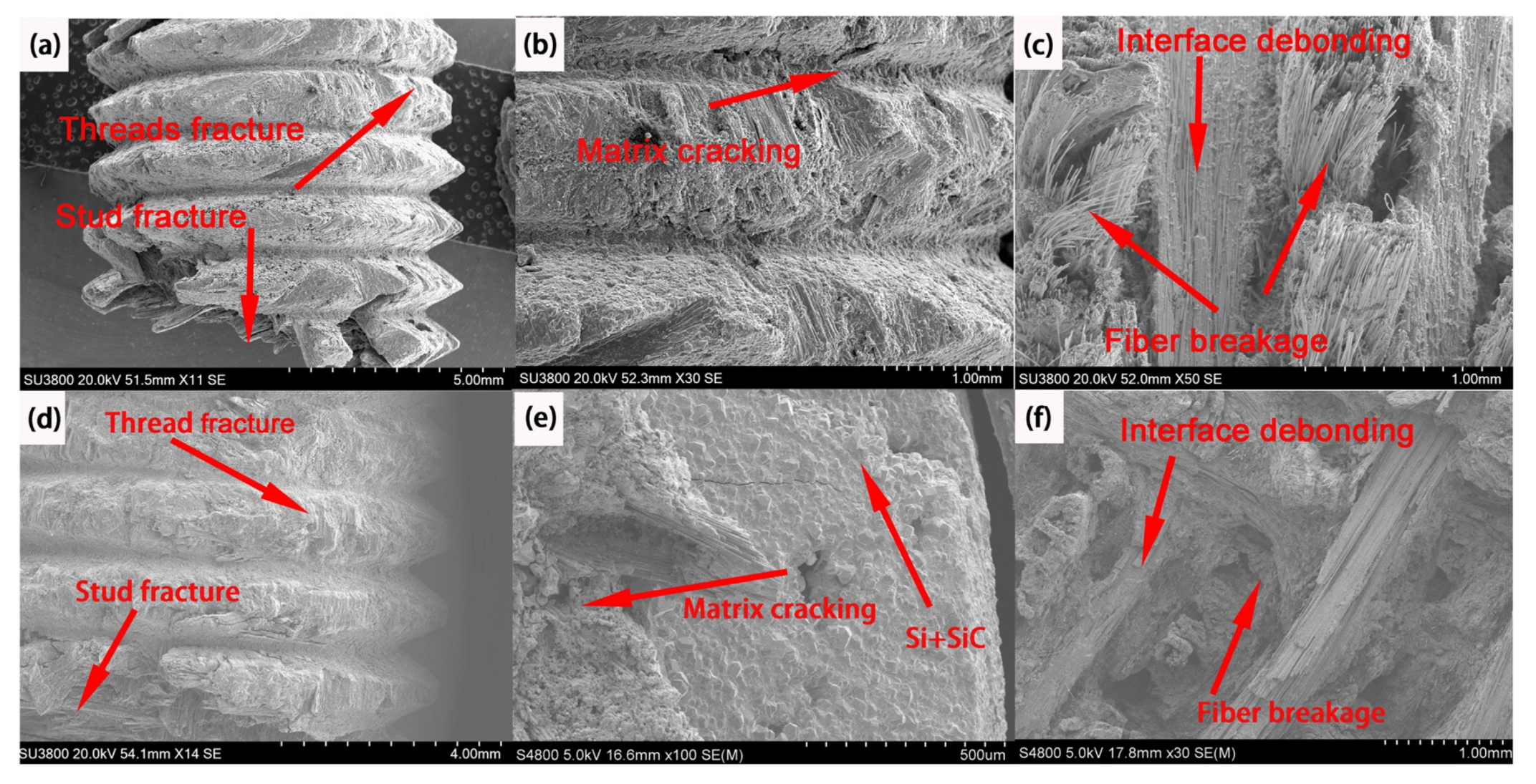
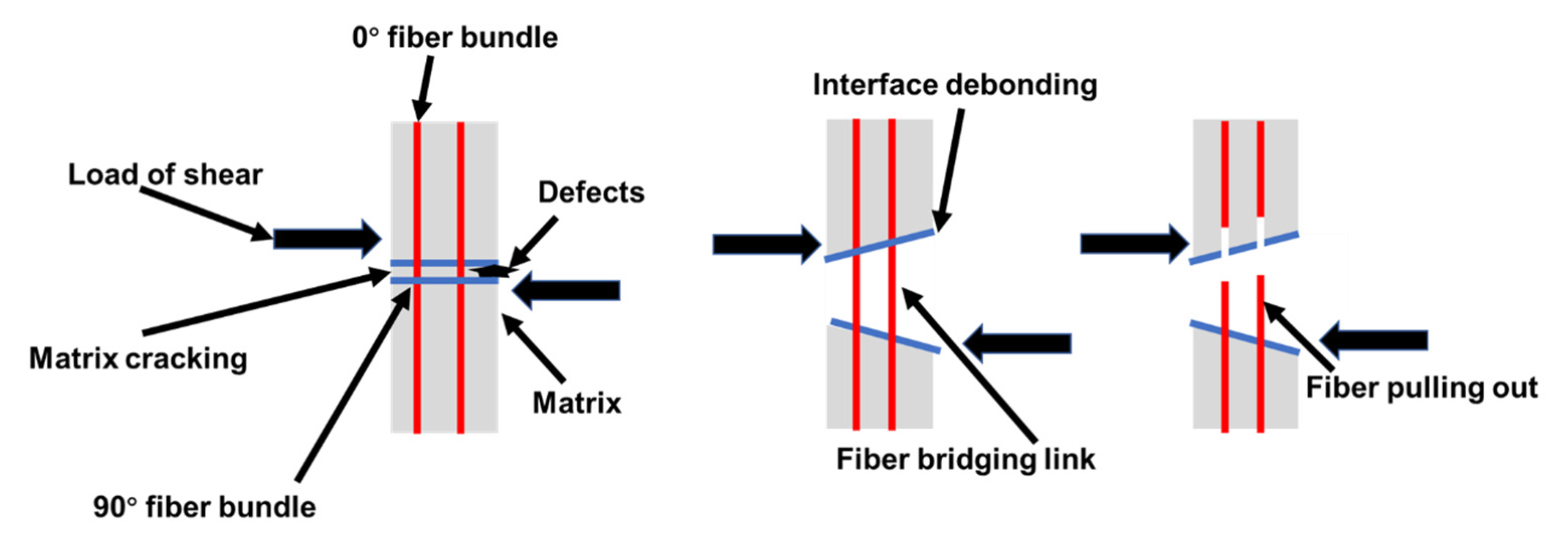
| Sample | Tensile Strength/MPa | Double−Sided Shear Strength/MPa | Compression Load/N |
|---|---|---|---|
| C/C | 43.49 ± 5.80 | 43.88 ± 4.29 | 3518.67 ± 309.61 |
| C/C−SiC | 55.16 ± 5.17 | 54.73 ± 4.73 | 3770.00 ± 369.61 |
Disclaimer/Publisher’s Note: The statements, opinions and data contained in all publications are solely those of the individual author(s) and contributor(s) and not of MDPI and/or the editor(s). MDPI and/or the editor(s) disclaim responsibility for any injury to people or property resulting from any ideas, methods, instructions or products referred to in the content. |
© 2023 by the authors. Licensee MDPI, Basel, Switzerland. This article is an open access article distributed under the terms and conditions of the Creative Commons Attribution (CC BY) license (https://creativecommons.org/licenses/by/4.0/).
Share and Cite
Sun, G.; Tan, Z.; Zhang, Q.; Zhang, Y.; Li, X.; Tian, Q.; Tang, Y. Influence of Si and SiC Coating on the Microstructures and Mechanical Properties of C/C Bolts. Materials 2023, 16, 1785. https://doi.org/10.3390/ma16051785
Sun G, Tan Z, Zhang Q, Zhang Y, Li X, Tian Q, Tang Y. Influence of Si and SiC Coating on the Microstructures and Mechanical Properties of C/C Bolts. Materials. 2023; 16(5):1785. https://doi.org/10.3390/ma16051785
Chicago/Turabian StyleSun, Guodong, Zhiqiang Tan, Qing Zhang, Yi Zhang, Xuqin Li, Qinglai Tian, and Yuxing Tang. 2023. "Influence of Si and SiC Coating on the Microstructures and Mechanical Properties of C/C Bolts" Materials 16, no. 5: 1785. https://doi.org/10.3390/ma16051785
APA StyleSun, G., Tan, Z., Zhang, Q., Zhang, Y., Li, X., Tian, Q., & Tang, Y. (2023). Influence of Si and SiC Coating on the Microstructures and Mechanical Properties of C/C Bolts. Materials, 16(5), 1785. https://doi.org/10.3390/ma16051785





